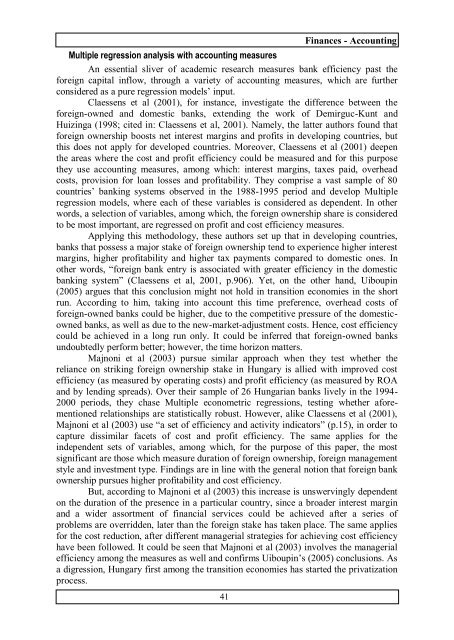The Young Economists Journal - Centru E-learning de Instruire al ...
The Young Economists Journal - Centru E-learning de Instruire al ...
The Young Economists Journal - Centru E-learning de Instruire al ...
- No tags were found...
Create successful ePaper yourself
Turn your PDF publications into a flip-book with our unique Google optimized e-Paper software.
41Finances - AccountingMultiple regression an<strong>al</strong>ysis with accounting measuresAn essenti<strong>al</strong> sliver of aca<strong>de</strong>mic research measures bank efficiency past theforeign capit<strong>al</strong> inflow, through a variety of accounting measures, which are furtherconsi<strong>de</strong>red as a pure regression mo<strong>de</strong>ls‟ input.Claessens et <strong>al</strong> (2001), for instance, investigate the difference between theforeign-owned and domestic banks, extending the work of Demirguc-Kunt andHuizinga (1998; cited in: Claessens et <strong>al</strong>, 2001). Namely, the latter authors found thatforeign ownership boosts net interest margins and profits in <strong>de</strong>veloping countries, butthis does not apply for <strong>de</strong>veloped countries. Moreover, Claessens et <strong>al</strong> (2001) <strong>de</strong>epenthe areas where the cost and profit efficiency could be measured and for this purposethey use accounting measures, among which: interest margins, taxes paid, overheadcosts, provision for loan losses and profitability. <strong>The</strong>y comprise a vast sample of 80countries‟ banking systems observed in the 1988-1995 period and <strong>de</strong>velop Multipleregression mo<strong>de</strong>ls, where each of these variables is consi<strong>de</strong>red as <strong>de</strong>pen<strong>de</strong>nt. In otherwords, a selection of variables, among which, the foreign ownership share is consi<strong>de</strong>redto be most important, are regressed on profit and cost efficiency measures.Applying this methodology, these authors set up that in <strong>de</strong>veloping countries,banks that possess a major stake of foreign ownership tend to experience higher interestmargins, higher profitability and higher tax payments compared to domestic ones. Inother words, “foreign bank entry is associated with greater efficiency in the domesticbanking system” (Claessens et <strong>al</strong>, 2001, p.906). Yet, on the other hand, Uiboupin(2005) argues that this conclusion might not hold in transition economies in the shortrun. According to him, taking into account this time preference, overhead costs offoreign-owned banks could be higher, due to the competitive pressure of the domesticownedbanks, as well as due to the new-market-adjustment costs. Hence, cost efficiencycould be achieved in a long run only. It could be inferred that foreign-owned banksundoubtedly perform better; however, the time horizon matters.Majnoni et <strong>al</strong> (2003) pursue similar approach when they test whether thereliance on striking foreign ownership stake in Hungary is <strong>al</strong>lied with improved costefficiency (as measured by operating costs) and profit efficiency (as measured by ROAand by lending spreads). Over their sample of 26 Hungarian banks lively in the 1994-2000 periods, they chase Multiple econometric regressions, testing whether aforementionedrelationships are statistic<strong>al</strong>ly robust. However, <strong>al</strong>ike Claessens et <strong>al</strong> (2001),Majnoni et <strong>al</strong> (2003) use “a set of efficiency and activity indicators” (p.15), in or<strong>de</strong>r tocapture dissimilar facets of cost and profit efficiency. <strong>The</strong> same applies for thein<strong>de</strong>pen<strong>de</strong>nt sets of variables, among which, for the purpose of this paper, the mostsignificant are those which measure duration of foreign ownership, foreign managementstyle and investment type. Findings are in line with the gener<strong>al</strong> notion that foreign bankownership pursues higher profitability and cost efficiency.But, according to Majnoni et <strong>al</strong> (2003) this increase is unswervingly <strong>de</strong>pen<strong>de</strong>nton the duration of the presence in a particular country, since a broa<strong>de</strong>r interest marginand a wi<strong>de</strong>r assortment of financi<strong>al</strong> services could be achieved after a series ofproblems are overrid<strong>de</strong>n, later than the foreign stake has taken place. <strong>The</strong> same appliesfor the cost reduction, after different manageri<strong>al</strong> strategies for achieving cost efficiencyhave been followed. It could be seen that Majnoni et <strong>al</strong> (2003) involves the manageri<strong>al</strong>efficiency among the measures as well and confirms Uiboupin‟s (2005) conclusions. Asa digression, Hungary first among the transition economies has started the privatizationprocess.















